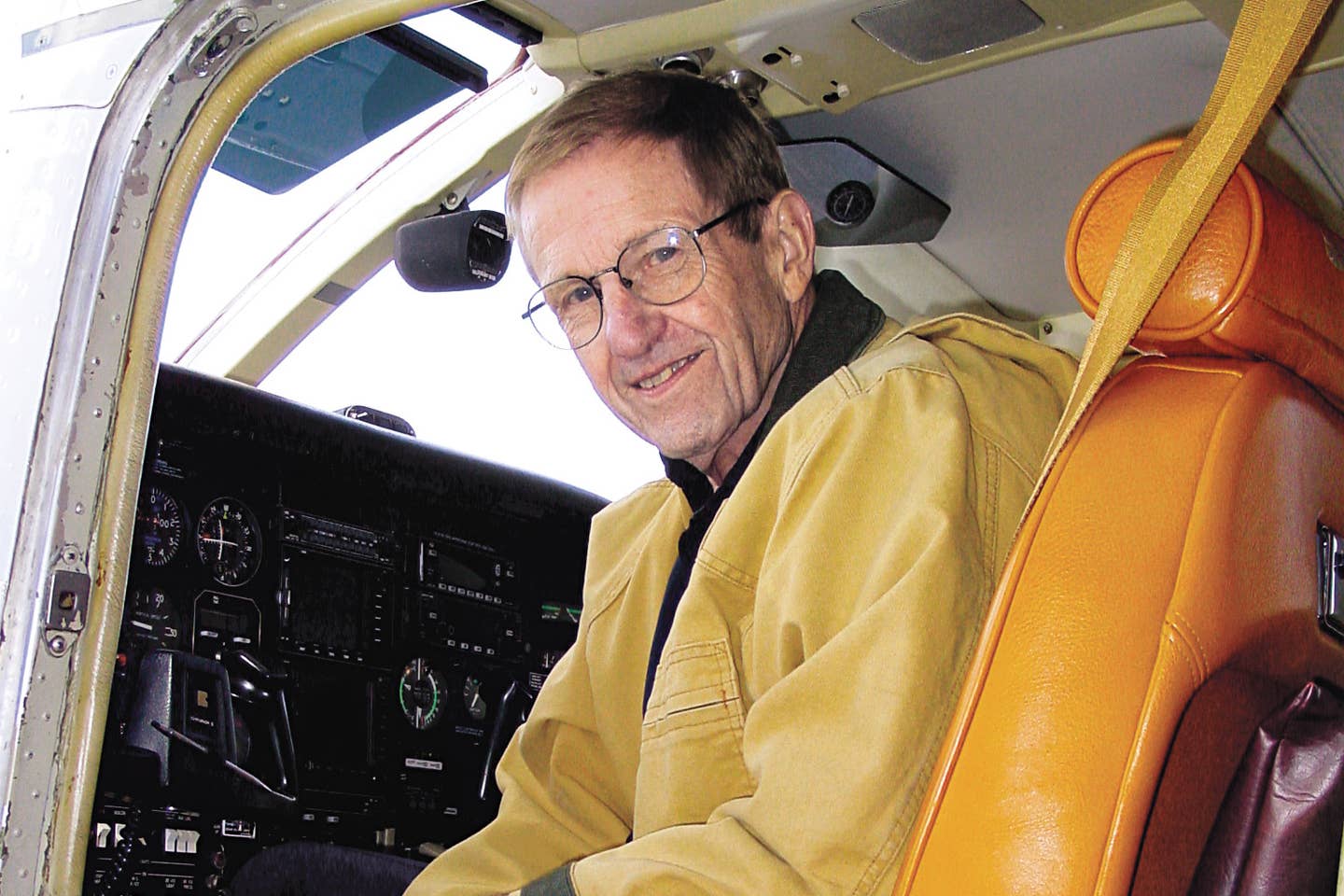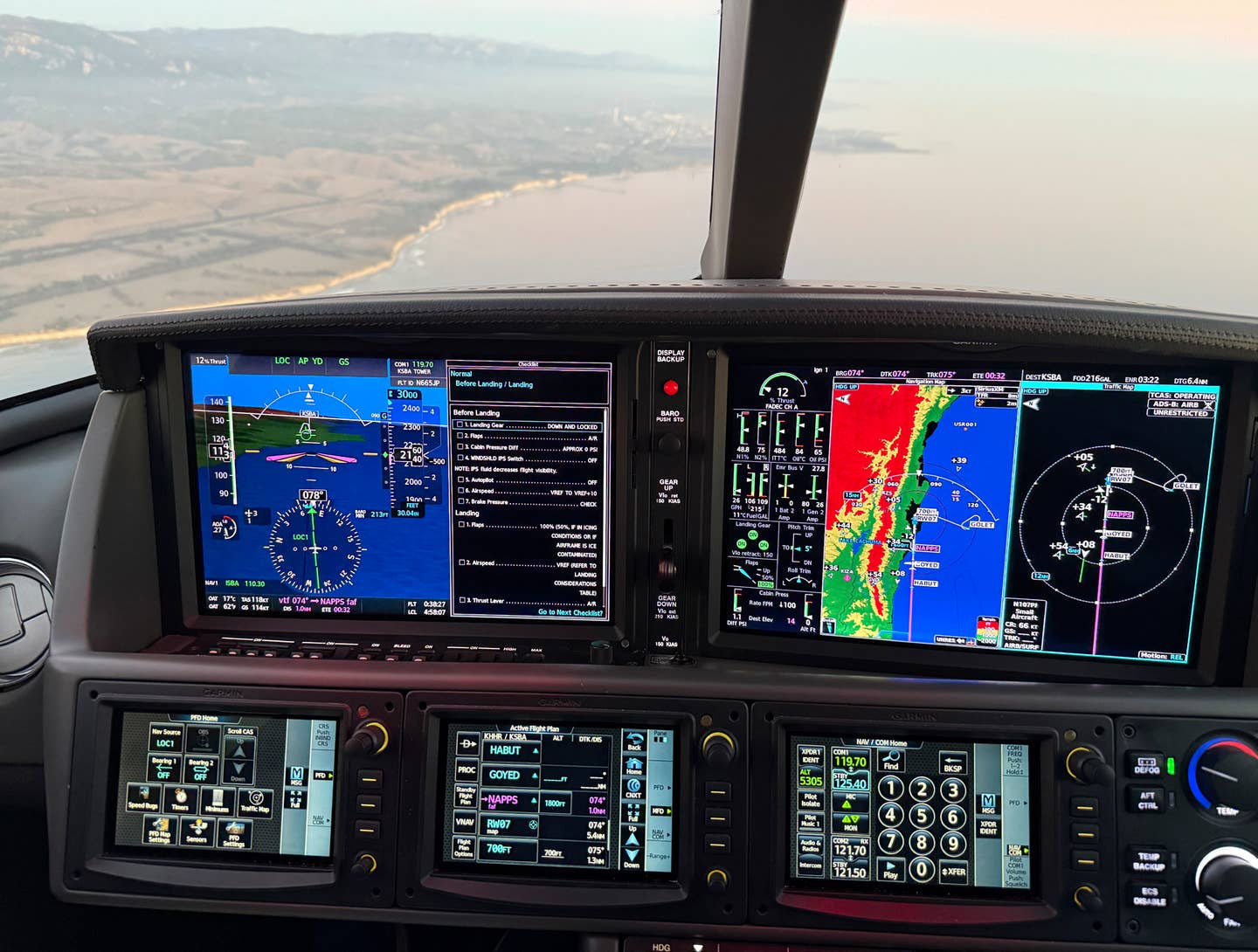
Dick Karl sought guidance on landing well from Richard Collins, coming away impressed by Collins’ skill in the P210. Flying Archives
From the very beginning, my children were instructed to greet each landing with praise. As long as the crash didn’t dislodge any loose teeth—or, later on, their retainers—it was expected that they would utter an obligatory congratulation. Today, my grandchildren make a big point out of yelling, “Nice landing, Pop,” as I shut down. They may actually mean what they say.
This custom began out of desperate need. I have never been a good “lander.” Though I pored over articles by Richard Collins about how a stabilized approach produced soft landings, I never seemed to master that last inch and a half of touchdown. While in the Army, I bought a used Beechcraft Musketeer in 1971. I was so sorry at landing that I commissioned a friend to stand next to a rural runway and photograph the Musketeer on approach and landing. The photos looked just like ones in the magazine, but the actual experience in the airplane was jarring. For a while, I became so frustrated with bounced and porpoised landings that I retracted the flaps at the first hint of contact with the ground.
Subsequent airplanes—Cessna 210s—didn’t help. The 210s were nose-heavy, and I never did achieve that paintbrush feeling of a gentle runway caress. Just getting the airplane on the ground on the centerline somewhere near the aiming point was about the best I could do. Even that was only on occasion.
Years later, the legendary Collins went out of his way to take me from White Plains, New York (KHPN), to Syracuse (KSYR). Now I would see if he was as good as his writing implied. A brisk crosswind bounced us around, but at just the last second, Collins straightened out the green-and-white P210, lowered the left wing, and we kissed the pavement. “OK,” I thought. “It is possible.”
As my fortunes increased, my wife, Cathy, and I bought a Cessna 340. With two engines, pressurization and ramp presence to spare, I was living large. I was proud beyond reason and an eager showoff to a friend of mine who had bought a Beechcraft P Baron. With the airstair door and a mighty-high cockpit, I was showing off on a short flight. When we landed, my friend said, “Nice landing…for a carrier.” Well, he was a neurosurgeon, and they aren’t usually the most politic of people.
About that time, Cathy had soloed in a Cessna 172. Unfortunately, she had acquired her landing skills from me—a conjugal affliction. Our friend JC, a retired Northwest Boeing 747 pilot, offered to help. He said: “Dick, you go to work. I’ll take Cathy in the rental 172, and we’ll do several landings until she gets it.”
That night, over martinis and scotch, JC took me aside and said: “Dick, she’s a good pilot. She is great on the radio. She holds heading and altitude beautifully, but when it comes to landing, well, she’s dangerous.” So ended Cathy’s pursuit of a private license. Thankfully, it did not end her support of our airplanes.
For 17 years, we owned a Piper Cheyenne I. This magnificent beast was reliable, faster than any previous airplane, burned jet-A and loved cruising in the low 20s. After almost 2,000 happy hours, I still could not predictably land this airplane with finesse. Sometimes I would flare too soon, drop the nose and then decide to pull back, resulting in a comical oscillation down the runway. Every once in a while, I’d luck into a smooth touchdown with this unintended, unorthodox approach. Occasionally, I’d get a “greaser,” but more often, I’d get a landing. Sometimes I’d get a collision. When we finally sold this airplane that I loved, we took a last short flight from Teterboro, New Jersey (KTEB), to Lebanon, New Hampshire (KLEB). Sure enough, I dropped it on. Luckily, the mighty Cheyenne had adamantine struts.
Read More from Dick Karl: Gear Up
In case you think it is just us amateurs who obsess over landings, my airline friends do too. Many fly the Boeing 737-700 or -800, which are difficult airplanes to land smoothly. One friend was doing his initial operating experience and was just finishing up his first three-day trip. After a long day with several landings, the captain offered him the last leg of the day. “Dick,” he said. “It was late, and I was tired. Landing in Oakland, California, I was feeling pretty good about everything. Then I dropped it on. The captain said, ‘Keep the cockpit door closed until everybody gets off.’” The new hire told me: “We sat there in the darkness and shut down. It was quiet. Then a flight attendant opened the door, stuck her head in and said simply, ‘Keep practicing!’”
My landing woes received miraculous treatment when I began flying professionally. Suddenly, I could pretty much get soft touchdowns. I attributed this improvement of fortune to the muscle memory gained by repetitive landings. As a hobby flyer, I would perseverate over a bad landing while at work—sometimes for two or three weeks before I flew again. At the Part 135 charter operation, I was sometimes making five landings a day in the Cessna Citation CJ3. I was getting the hang of it—or so I thought. Then, my captain said: “This airplane has trailing-link landing gear. It makes anybody look good.”
So it did. I will leave it to Peter Garrison to describe the physics involved, but I do remember one landing in Dallas in winter. There was a blistering crosswind underneath a cloud deck at minimums. I set down that left main so gently, I was not certain we’d landed. The first officer said, “Nice landing.”
Even so, I could occasionally screw up an easy CJ3 landing. After an inexplicable collision between rubber and concrete on a clear day with no wind, Capt. Martin Parker turned to me. “How did you do that?” The good thing about flying professionally was that you’d get another chance, maybe even later that day.
On one happy trip, I was reunited with the kind captain who had done my IOE. When we met up, Fred Pollino said to me: “Dick, I’ve been instructing and evaluating for eight days. Do you mind if I fly today?” This was typical Fred—generous and open. We started up in the Northeast and flew to Atlanta (KATL) where he made a picture-perfect landing. We smiled. When we landed in Naples, Florida (KAPF), the landing was even better. So it was on to Boca Raton, Florida (KBCT): our last leg and Fred’s last landing before vacation. The approach in fading sunlight was the kind they make movies about. The sun, low in the sky, cast long shadows and magnificent light on the swaying palm trees. “One thousand, stable,” I said. At 50 feet, I said, “Ref plus two—perfect.” With that, the airplane fell from the sky as if it were an anvil. We were both shocked. Then this highly accomplished airman turned to me and said, “So this is how it ends.”
“Nice landing, Pop,” I said, and we laughed.
This story appeared in the November 2020, Buyers Guide issue of Flying Magazine

Sign-up for newsletters & special offers!
Get the latest FLYING stories & special offers delivered directly to your inbox






